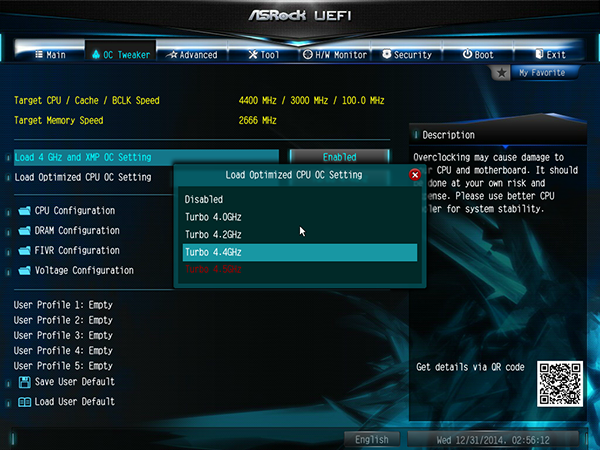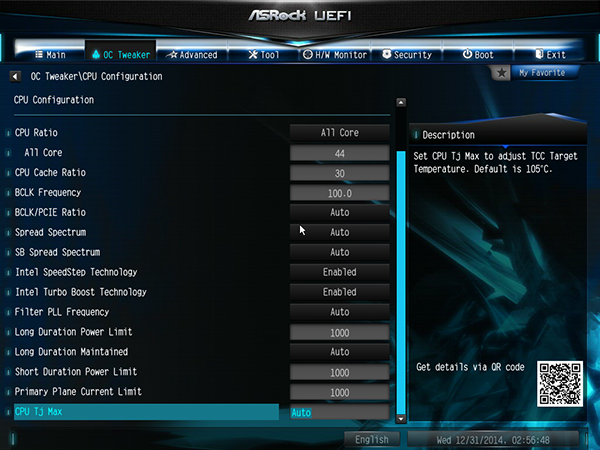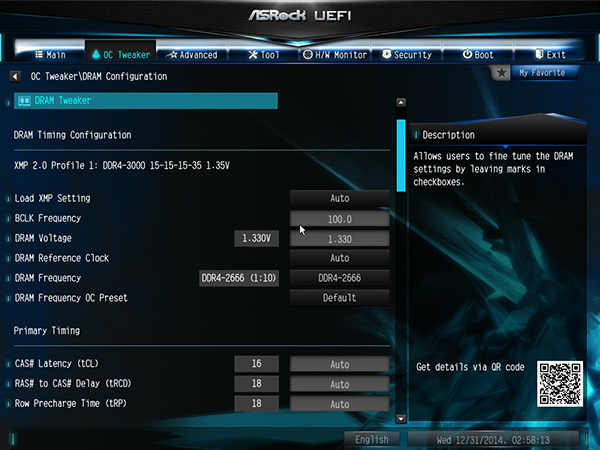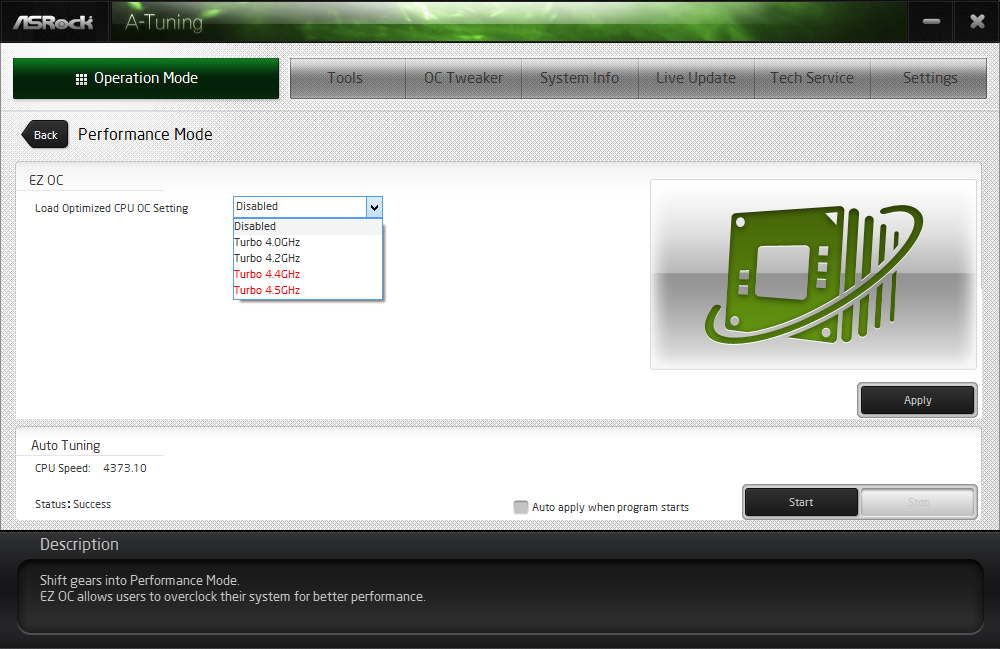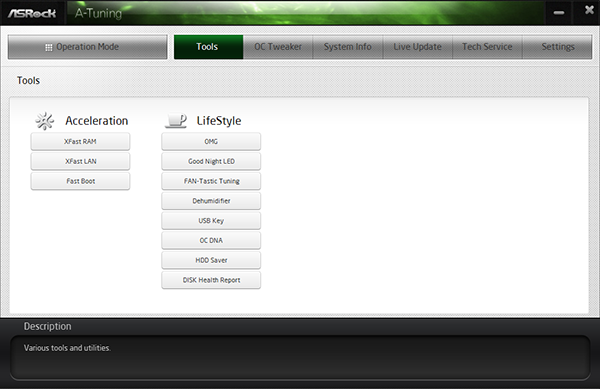ASRock X99 Extreme6/ac Motherboard Review
Featuring the same wireless controller as its closest competitor, ASRock’s X99 Pro adds a second gigabit Ethernet controller and removes a few pathway sharing issues. Have we finally found a value-winning solution for high-end LGA 2011-v3 buyers?
Why you can trust Tom's Hardware
X99 Extreme6/ac Firmware And Software
Manufacturer-defined overclocks within the X99 Extreme6/ac's firmware include 4GHz at 1.20V core, 4.2GHz at 1.22V, 4.4GHz at 1.31V and 4.5GHz at 1.36V. Those voltage are high enough to stabilize the frequencies, but anything beyond 1.30V often causes thermal throttling on our Haswell-E sample that acts like Turbo Boost…in reverse.
Getting to the usual 44x CPU multiplier with a 1.28V core voltage was easy (as usual), but going from there to a 101MHz BCLK caused the system to crash. We were stuck at 4.4GHz, rather than the expected 4.44GHz.
ASRock doesn’t expose any hidden memory ratios, limiting the X99 Extrem6 to the 10x ratio of less feature-rich boards. That gets enthusiasts a 2666MT/s data rate at the DRAM controller’s 4:3 ratio (1.33x) to the CPU core.
The X99 Extreme6/ac still supports our memory’s DDR4-3000 XMP setting, but only by specifying a 1.25x strap and corresponding 125MHz BCLK. Hiding its over-voltage, our meter showed an actual 1.349V at the 1.330V setting.

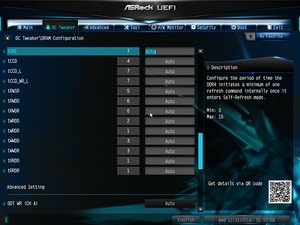
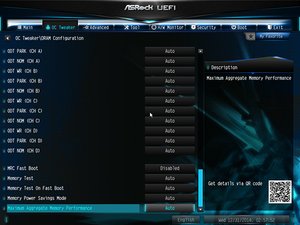
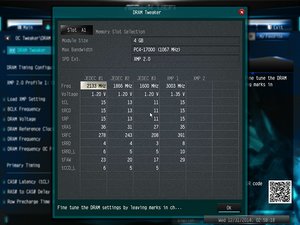
The X99 Extreme6/ac includes a full range of primary, secondary and tertiary timings. A pop-up “DRAM Tweaker” menu provides a list of the memory’s rated settings.

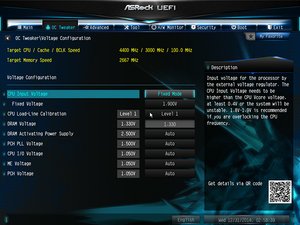
A 1.282V setting bumped the CPU core over its initial 1.279V at 1.28V.
APP Shop is ASRock’s downloader program, where the “Apps” page is little more than a group of freeware links. Most valuable of these in dollar terms is ASRock Cloud, which is a free year’s subscription to Orbweb ME hosting service.
Get Tom's Hardware's best news and in-depth reviews, straight to your inbox.
ASRock A-Tuning includes an auto-tuning algorithm that’s supposed to gradually increase clock speed while cycling stability tests to reach the CPU’s optimal setting. It found 4.37GHz at 1.20V (CPU core) and enabled XMP at 1.38V (memory), but Prime95 crashed after several seconds of running an AVX-optimized multi-core load. Noting that our CPU’s memory controller doesn’t appear to work well at voltage levels in excess of 1.365V, your results may be better.


Manual configuration is a viable option, with A-Tuning providing Windows-based access to the full range of firmware-level voltage and frequency controls. We were able to confirm that processor voltage, multiplier and platform BCLK are all configurable without rebooting.
Since A-Tuning hasn’t been significantly revised in a long time, other software features remain consistent with our previous X99 Extreme4 review. These include XFast RAM (RAM disk), XFast LAN (packet prioritization by cFOS), FAN-Tastic fan speed tuning, “Dehumidifier” artificial load cycling, USB Key login authentication and the control app for the included HDD Saver hard drive power cable.
Current page: X99 Extreme6/ac Firmware And Software
Prev Page ASRock’s X99 Extreme6/ac In Detail Next Page Results: Performance, Power, Efficiency And Overclocking-
vertexx Still looking for the value X99 board without too many trade-offs. What would be helpful for me is a chart comparing the x99 board with the various slot/lane options for the 5820 vs. 5930/5960 CPUs.Reply -
JeanLuc You haven't shown any results for the SATA and ESATA throughput, the USB controllers transfer speeds (Intel speeds I would guess are the same across the board but what the 3rd party controllers?).Reply
Anyone who is buying this will also want to know how good the wireless AC and bluetooth that have been bundled with the motherboard are.
How good is the sound chip? Can you hear background static when you have earphones plugged in if so how bad? Has the manufacturer made any effort to isolate background noise and how effective are those measures?
There is so much you have missed in this "review". -
Crashman Reply
Right now Gigabyte has the best lane configuration and slot spacing four four cards, MSI has the best lane configuration and slot spacing for three. Gigabyte has the USB 3.0 header blocked by a fourth card, MSI has the three cards + PCIe x4 M.2 +USB 3.0 configuration nailed (if you care about PCIe x4 M.2). You'll see another MSI board in a review still pending its publishing date.15149683 said:Still looking for the value X99 board without too many trade-offs. What would be helpful for me is a chart comparing the x99 board with the various slot/lane options for the 5820 vs. 5930/5960 CPUs.
-
Crashman Reply
That's it, I'm asking Adam Overa to find a controller tester :) We should have a collection of standard controller test results to link when discussing the inclusion of these parts on a motherboard.15149944 said:You haven't shown any results for the SATA and ESATA throughput, the USB controllers transfer speeds (Intel speeds I would guess are the same across the board but what the 3rd party controllers?).
Anyone who is buying this will also want to know how good the wireless AC and bluetooth that have been bundled with the motherboard are.
How good is the sound chip? Can you hear background static when you have earphones plugged in if so how bad? Has the manufacturer made any effort to isolate background noise and how effective are those measures?
There is so much you have missed in this "review".
-
vertexx Reply15153170 said:Right now Gigabyte has the best lane configuration and slot spacing four four cards, MSI has the best lane configuration and slot spacing for three. Gigabyte has the USB 3.0 header blocked by a fourth card, MSI has the three cards + PCIe x4 M.2 +USB 3.0 configuration nailed (if you care about PCIe x4 M.2). You'll see another MSI board in a review still pending its publishing date.
That about summarizes it - thanks! I'm looking at a 5820k based rig. Long term goal is water-cooled 3-way x8 + PCIe x4 M.2. So, MSI has that configuration down. Shorter term would more realistically be air-cooled 2-way, and my understanding is the MSI is not the best for 2-way air cooled due to the slot spacing.
So I think I'm looking for a board that can do both a (1) dual SLI x16/x0/x8 + x4 M.2 or (2) 3-way SLI x8/x8/x8 +x4 M.2, all at just above $200.
The lowest price board I could find that can do this is the ASRock x99 Fatal1ty Pro or OC Formula, both in the $340-350 price range. The Professional happens to have a $40 rebate plus $85 DDR4 combo discount, making this a ~$220 proposition for this board. Tempting......
http://www.newegg.com/Product/Product.aspx?Item=N82E16813157539 -
Crashman Reply
Please consider our first roundup:15154249 said:15153170 said:Right now Gigabyte has the best lane configuration and slot spacing four four cards, MSI has the best lane configuration and slot spacing for three. Gigabyte has the USB 3.0 header blocked by a fourth card, MSI has the three cards + PCIe x4 M.2 +USB 3.0 configuration nailed (if you care about PCIe x4 M.2). You'll see another MSI board in a review still pending its publishing date.
That about summarizes it - thanks! I'm looking at a 5820k based rig. Long term goal is water-cooled 3-way x8 + PCIe x4 M.2. So, MSI has that configuration down. Shorter term would more realistically be air-cooled 2-way, and my understanding is the MSI is not the best for 2-way air cooled due to the slot spacing.
So I think I'm looking for a board that can do both a (1) dual SLI x16/x0/x8 + x4 M.2 or (2) 3-way SLI x8/x8/x8 +x4 M.2, all at just above $200.
The lowest price board I could find that can do this is the ASRock x99 Fatal1ty Pro or OC Formula, both in the $340-350 price range. The Professional happens to have a $40 rebate plus $85 DDR4 combo discount, making this a ~$220 proposition for this board. Tempting......
http://www.newegg.com/Product/Product.aspx?Item=N82E16813157539
http://www.tomshardware.com/reviews/intel-x99-haswell-e-overclocking,3934.htmlIt has 2nd-tier (price-range) X99 motherboards with Gigabyte, ASRock and MSI compared, and it has the PCIe stuff you're looking for. In regards to the 5820K, MSI has "4 (x16/x8/x0/x4*, x8/x8/x8/x4*) *Forces M.2 to PCIe 2.0 x2" What this means is that the fourth slot is shared between M.2 and "PCIe x16 slot 4" I believe MSI's entire X99 range is made the same way, apart from the boards that have a PCIe 48-lane switch.
So MSI gets you 3-way + an x4 M.2. Most people are only interested in 2 way SLI as a future upgrade, and ASRock does 2-way + an x4 M.2.
It could be a while before we get down to the lowest X99 pricing tier, but expect coverage of MSI's cheap X99 board in "some other kind of article" three weeks from now.
